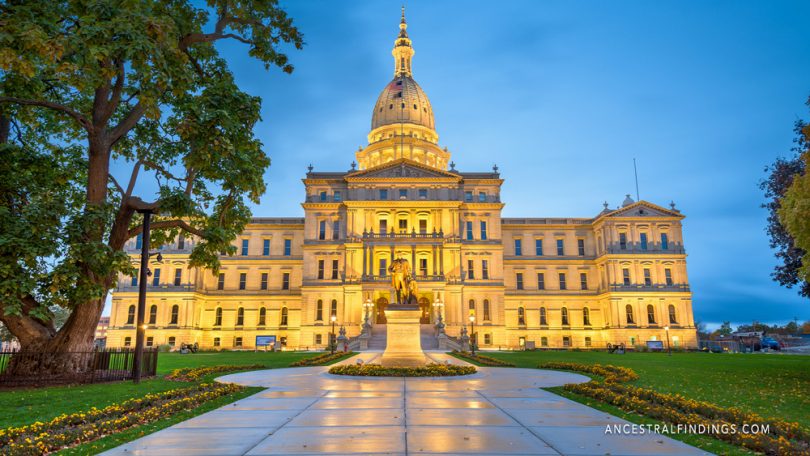Lansing is the state capital of Michigan in the United States. The city is located in three different counties, with most of it being in Ingham County, but with parts of the city also being in Eaton County and in Clinton County. It has a population of around 114,000 people and is the fifth most populous city in Michigan. Lansing became the state capital of Michigan in 1847, which was ten years after Michigan achieved statehood.
Lansing is the only state capital in the United States that is not a county seat (with the exception of three that are not actually located within counties). Lansing being within a county and not being the county seat makes it unique among the state capitals. This may be because it crosses into three counties. However, the county seat of Ingham County, where the largest portion of Lansing is located, which is the city of Mason, does keep some county offices in Lansing.
While Native Americans have lived in the area that is now Lansing for thousands of years or more, the first record of a person of European descent to visit Lansing was a British fur trader named Hugh Heward in 1790. Heward and his team of French-Canadian traders arrived at the area that would become Lansing while they were canoeing on the Grand River.
The land that later became Lansing was surveyed in 1827 and labeled as Township 4 North Range 2 West. At the time, the area was mostly dense forest. Lansing was the last of the townships in Ingham County to be surveyed, probably because of its sparsely inhabited, mostly forested nature. The land that would become Lansing was offered for sale in October of 1830. No roads were even built to or within Lansing for many more decades after the sale of the land.
In the winter of 1835, two brothers who were from New York plotted an area of land near what would become downtown Lansing and called it Biddle City (it is now known as REO Town). Biddle City was in a flood plain and spent most of the year underwater, so no town could be built there at the time. The brothers went home to Lansing, New York, and sold plots of land in this town that did not exist and could not be (at that time). The New Yorkers who purchased these plots were told that Biddle City had sixty-five blocks, a church, and an academic square. There were sixteen people who purchased plots of land in Biddle City.

The original capitol building in Detroit sometime around 1847.
When the buyers of these plots went to Biddle City and saw what it was, they knew the two brothers had scammed them. Some of them went back to New York in disappointment. Others decided to stay, settling just outside of Biddle City in the area that became downtown Lansing. They called their new home Lansing Township, after their old home of Lansing, New York.
The initial settlement in Lansing was less than twenty people. It was a dormant city with those few hardy settlers for another decade, until the winter of 1847. This was when the state constitution of Michigan required the state capital to be moved from Detroit to an area that was more central to the rest of the state, as well as safer; there was a concern about Detroit’s location in a close proximity to Canada, which was controlled by the British, who had captured Detroit during the War of 1812. While the United States re-captured Detroit in 1813, the need to have Michigan’s state capital as far as possible from Canada while still being easily accessible to most state residents was important. The leaders of the state also did not want Detroit, which was the state’s largest city, to have undue influence over the politics of Michigan as its largest city and state capital, too.
While discussing the location for the new state capital, there were several cities considered, including Jackson, Marshall, and Ann Arbor. Each city lobbied the state legislature hard to win the honor. Because of the pushiness of the other cities, while campaigning for the position, the state legislature quietly chose Lansing. Many present at the meeting of the legislature when Lansing was chosen laughed out loud at the choice. Lansing was perceived to be an insignificant settlement. Yet, the governor signed the order into law, making Lansing the state capital of Michigan.
After the announcement that Lansing was the new state capital, businesses and people flocked to it. By 1860, Lansing had a population of 3,000 and had grown to seven square miles. This was a long way from its humble beginnings of less than twenty settlers. The name Lansing Township was changed to Town of Michigan, temporarily, then was quickly changed to simply Lansing, which it is still called today. Two decades after its declaration as the state capital, the railroad had come to Lansing, it had a plank road, and the capital building, which is still there and being used, was completed in 1878.
What most people would recognize as modern Lansing began in 1897 when the Olds Motor Vehicle Company set up shop there. The company went through a few name changes over the years, as well as a buyout when founder Ransom E. Olds began a new company called REO Motor Car Company. That company became a staple Lansing business for the next seven decades. This founding in 1897 began the transformation of Lansing from insignificant settlement to state capital to a major center for the manufacturing of automobiles and their parts in America.
Lansing grew to fifteen square miles by 1960 and is currently approximately thirty-three square miles in size. It includes a diversified group of businesses, including manufacturing, government services, banking, education, healthcare, and insurance. The story of Lansing, Michigan could truly be called The Little Settlement that Could, because that is exactly what it did, and continues to do today. Lansing is a Michigan success story.







